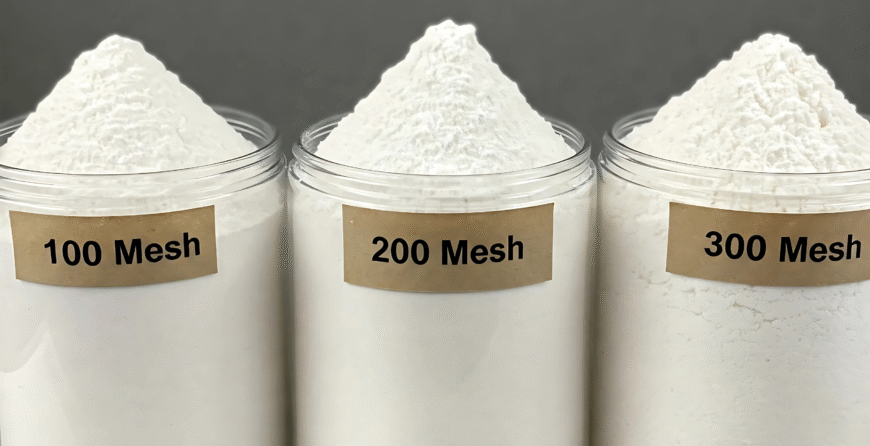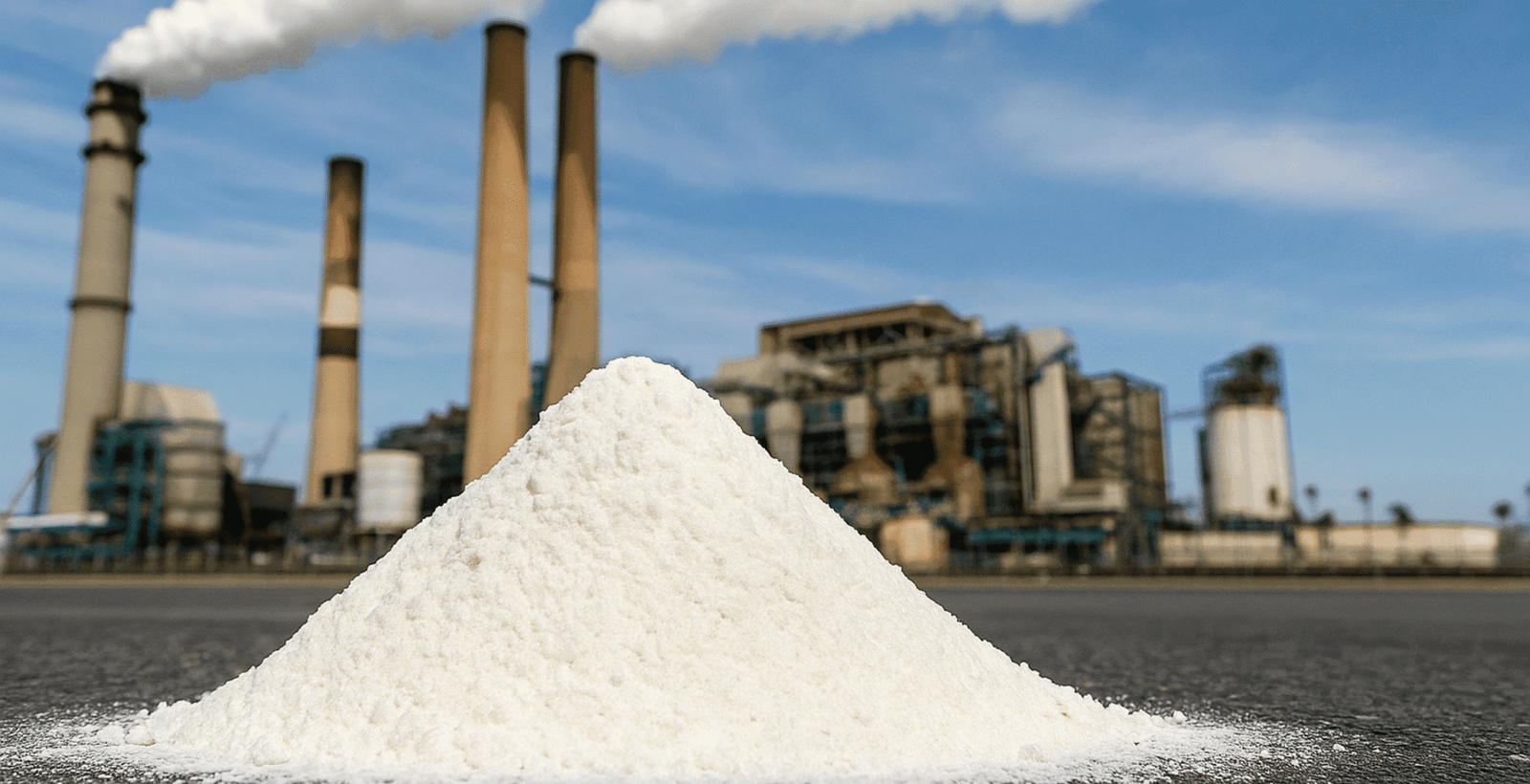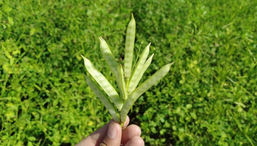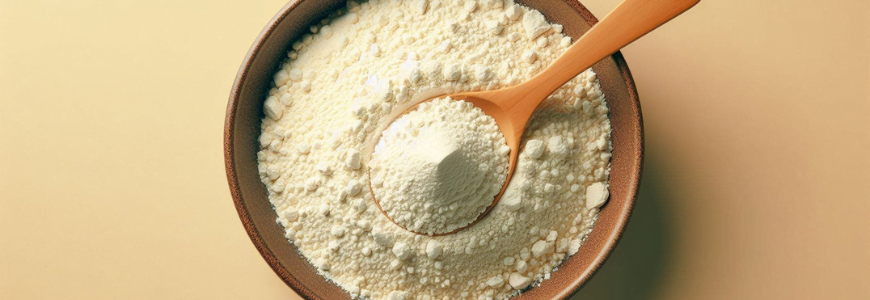If you’re new to the world of guar gum, you’ve probably come across the term “Guar Gum Mesh” or “Guar Gum Mesh Sizes” and wondered what it means. This blog is your easy-to-understand guide to what Guar Gum Mesh sizes are, why they matter, and how to choose the right one for your needs. Whether you’re using guar gum powder for food, cosmetics, or industrial purposes, understanding mesh sizes will help you get the best results. Let’s dive deeper with this blog –
What Is Guar Gum?
Before we dive into Guar Gum Mesh sizes, let’s take a quick look at what guar gum is.
Guar gum is a natural thickening agent made from guar beans. It is widely used in food processing, pharmaceuticals, cosmetics, and oil drilling. When guar beans are processed, the end product is a fine powder called guar gum powder. But not all guar gum powders are the same. One important difference is the mesh size.
What Does “Mesh Size” Mean?
Mesh size refers to how finely ground a powder is. It’s measured by how many holes per inch are in a screen (or sieve). For example:
1. 100 mesh means there are 100 holes per linear inch.
2. 200 mesh means there are 200 holes per linear inch.
The higher the number, the finer the powder.
So when we talk about Guar Gum Mesh, we are referring to how fine or coarse the guar gum powder is.
Common Mesh Sizes in Guar Gum:
Here are some of the most commonly used Guar Gum Mesh sizes:
1. 100 Mesh – Coarse powder
2. 200 Mesh – Medium-fine powder
3. 300 Mesh – Very fine powder
4. 325 Mesh – Ultra-fine powder (used in cosmetics and pharmaceuticals).
Each size has specific applications depending on how quickly and efficiently the powder needs to dissolve or perform in a product.
Why Is Mesh Size Important?
Mesh size affects:
1. Solubility: Finer powders dissolve faster.
2. Texture: In food, finer powders give a smoother texture.
3. Viscosity: Coarser powders might produce higher thickness more slowly.
4. Application Type: Some industries prefer specific mesh sizes based on their needs.
Applications of Different Guar Gum Mesh Sizes
100 Mesh – Coarse Guar Gum
1. Used in industrial applications
2. Ideal for oil drilling and fracking
3. Suitable for paper manufacturing
4. Slower hydration.
200 Mesh – Standard Guar Gum
1. Common in the food industry
2. Used in ice creams, sauces, and dressings
3. Balances good hydration and texture
4. Often labeled as food-grade guar gum
300 Mesh – Fine Guar Gum
1. Faster hydration
2. Preferred in cosmetics and personal care
3. Ideal for pharmaceutical suspensions
325 Mesh – Ultra-Fine Guar Gum
1. Best for tablets, lotions, and high-end cosmetics
2. Extremely smooth texture
3. Quick dispersion
How to Choose the Right Guar Gum Mesh:
When selecting a Guar Gum Mesh, consider the following:
1. End-Use: Are you using it in food, cosmetics, or industry?
2. Viscosity Requirement: Do you need it to thicken quickly?
3. Clarity and Texture: Do you want a smooth finish?
4. Hydration Time: How fast should it dissolve?
If you’re making a salad dressing, a 200 mesh powder would be ideal. But for a face cream, a 300 or 325 mesh would offer a smoother result.
Industrial-Wise Use of Guar Gum Mesh Size:
Recommended mesh sizes for various sectors:
1. Food products: Go with 200–300 mesh
2. Cosmetics or skincare: Choose 300–325 mesh
3. Oil and industrial use: Stick to 100 mesh
4. Pharmaceuticals: Use 325 mesh
Always ask for:
1. COA (Certificate of Analysis)
2. TDS (Technical Data Sheet)
These tell you if the guar gum mesh size meets your quality needs.
Important Tip: Don’t Ignore Mesh Size!
Even if the guar gum looks the same, different mesh sizes can give completely different results.
-> Wrong mesh = product failure
-> Right mesh = better results, satisfied customers
So always confirm the Guar Gum Mesh when placing an order or developing a product.
How Guar Gum Is Processed into Mesh Sizes:
Once guar beans are harvested and dried, they are dehusked and ground into splits. These splits are then milled into a powder. The powder is passed through sieves to separate it into different Guar Gum Mesh sizes.
Machines like pulverizers, screen classifiers, and cyclones help in this process. The final product is then packed according to the desired mesh specification.
How Is Guar Gum Mesh Achieved?
How Is Guar Gum Mesh Achieved?
After guar beans are processed into splits, the splits go through steps like:
1. Grinding – Converts splits into powder
2. Sieving – Sorts the powder into mesh sizes
3. Air classification – Separates particles based on size
4. Packaging – According to customer needs. We, Durga Enterprises, provide packaging such as Paper Bags inside Polyliner, Jumbo Bags packaging, etc.
Each batch is then tested for viscosity, purity, moisture content, and mesh size.
Guar Gum Mesh Size in the Food Industry:
In the food industry, mesh size is important for:
1. Texture
2. Solubility
3. Shelf life
4. Product consistency
For example, guar gum used for baking often requires a 200 or 300 mesh for even mixing and moisture retention.
Guar Gum Mesh Size in Industrial Use:
In oil and gas drilling, a coarser Guar Gum Mesh (like 100 mesh) is used. This type of guar gum swells slowly, which is ideal for controlling fluid loss.
In textiles and paper production, coarser mesh sizes are also favored for better film-forming properties.
Guar Gum Mesh Size in Cosmetics and Pharma:
Finer meshes (300 and 325) are used for:
1. Lotions
2. Creams
3. Toothpaste
4. Tablets
These powders blend easily with other ingredients and give a smooth, silky finish. Finer Guar Gum Mesh ensures there’s no grittiness in the end product.
Benefits of Understanding Guar Gum Mesh Sizes:
1. Helps you choose the right grade
2. Improves product quality
3. Reduces waste and cost
4. Increases shelf-life
5. Ensures better customer satisfaction
Summary:
Understanding Guar Gum Mesh size may seem technical, but it’s actually very simple—and very important.
1. It affects texture, solubility, and performance
2. Each industry prefers a different mesh size
3. Finer mesh = smoother texture
4. Coarser mesh = more stability and slower hydration
Make sure to choose the mesh size based on your product needs.
FAQs:
1. What does “mesh size” mean in guar gum?
Mesh size means how fine or coarse the guar gum powder is. A higher number means finer powder.
2. Why is mesh size important in guar gum?
Mesh size affects how the guar gum works in your product—like how fast it mixes, how smooth it feels, and how thick it becomes.
3. What mesh size is used in food products?
Most food items like ice creams, soups, and sauces use 200–300 mesh guar gum for smooth texture and quick mixing.
4. Which mesh size is good for cosmetics?
Cosmetic products like creams and shampoos usually need 300–325 mesh for a soft, smooth feel.
5. Can I use any mesh size for all applications?
No. Each industry needs a different mesh size. For example, oil drilling needs a coarse mesh, but skincare needs a fine mesh.
6. What is the finest guar gum mesh size?
The finest mesh size is usually 325 mesh, which is like a soft, smooth powder used in cosmetics and pharmaceuticals.
7. What mesh size is used in oil drilling?
100 mesh is common in oil drilling because it hydrates slowly and builds thick viscosity.
8. Is a higher mesh size always better?
Not always. Finer mesh is good for smooth products, but coarser mesh is better for industrial uses where slower hydration is needed.
9. How can I know the mesh size of guar gum before buying?
Ask the supplier for a CoA (Certificate of Analysis) or TDS (Technical Data Sheet). These papers will show the mesh size.
10. Is there a standard mesh size for guar gum?
No single standard. The best mesh size depends on what product you’re making or using it for.







